December 25th, 2010
 The placebo effect is powerful and widespread in medicine. It involves patients getting better when they take a medication or therapy that has no clinical value or active ingredients. Often used as a control to test the efficacy of other treatments, the impact of placebos demonstrates the power of perception and belief in creating change. Indeed, the placebo effect is one reason I am high on cognitive design, a think-and-feel can have as much functional impact as a hammer and nail. It is the real thing not frosting on the design cake. It turns out we all have our placebos.
The placebo effect is powerful and widespread in medicine. It involves patients getting better when they take a medication or therapy that has no clinical value or active ingredients. Often used as a control to test the efficacy of other treatments, the impact of placebos demonstrates the power of perception and belief in creating change. Indeed, the placebo effect is one reason I am high on cognitive design, a think-and-feel can have as much functional impact as a hammer and nail. It is the real thing not frosting on the design cake. It turns out we all have our placebos.
Leveraging placebos outside of clinical trials involves deception and raises ethical issues. But do you have to deceive people for placebos to work? According to a recent study by the Harvard Medical School, Placebos Work – Even Without Deception, the answer is no. They found that nearly twice the patients with irritable bowel syndrome that knowingly took placebos experienced symptom relief. The control or comparion group took nothing.
It was very clear that placebos were being used:
“Not only did we make it absolutely clear that these pills had no active ingredient and were made from inert substances, but we actually had ‘placebo’ printed on the bottle,” says Kaptchuk. “We told the patients that they didn’t have to even believe in the placebo effect. Just take the pills.”
 If this effect can be reproduce in other contexts it signals an important development for cognitive designers. It illustrates the importance of ritual (in this case the clinical ritual of taking medications) in creating change. This may support arguments claiming prayer, teaching and leadership communication involve placebo-like effects.
If this effect can be reproduce in other contexts it signals an important development for cognitive designers. It illustrates the importance of ritual (in this case the clinical ritual of taking medications) in creating change. This may support arguments claiming prayer, teaching and leadership communication involve placebo-like effects.
It is the belief in positive outcomes amplified by the psychology of authority-led rituals that is doing the work not the science of the intervention!
How might leaders and mangers driving behavior and organizational change put this to use? Can we label a change technique or management idea a placebo and generate results?

Posted in Behavior Change, Related Fields, Service Innovation | No Comments »
December 22nd, 2010
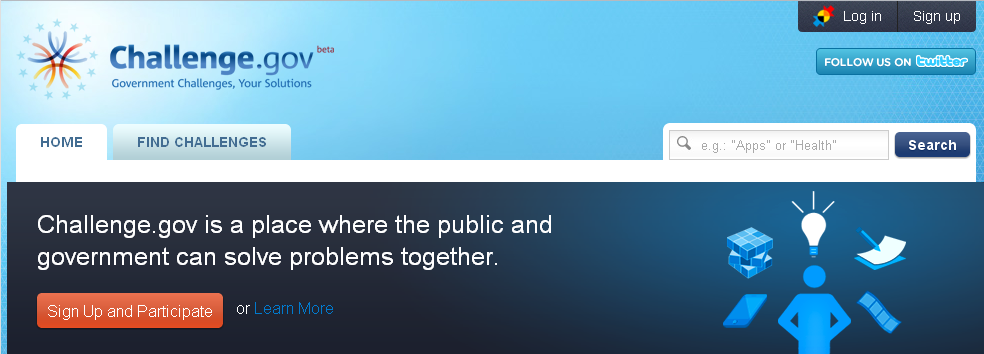
The US federal government has embraced open innovation. The goal is to accelerate innovation, resolution of tough problems and an agency’s core mission by offering cash prizes to all comers.
Challenge.gov has 56 challenges from 27 organization so it appears to be getting traction. Most of the prizes are a few thousand dollars but I did see one for $50K.
Some of the challenges definitely involve cognitive design. For example check out, the Healthy People 2020 contest. They are looking applications that help professionals participate in our national agenda for disease prevention and health promotion. Contests in the education and health category tend to have a cognitive design element.
Interested to hear from readers that are participating in Challenge.gov.

Posted in Design, Events | No Comments »
December 20th, 2010

There is a great post on the PsyBlog summarizing 20 principles for changing minds. While we have covered nearly all of the principles for persuasion in other posts, pulling a list like this together has some real value for cognitive designers.
Very interested to hear from readers on how best to implement some of these principles and which are the most powerful.

Posted in Behavior Change, Psychographics | No Comments »
December 16th, 2010

The world of work has change radically but the world of management has not. Work is now service not product, network not hierarchy, intangible value not cash flow, open not proprietary, crowdsourced not outsourced and untethered not done in the corporate office. What customer, employee, value, organization and strategy mean has fundamentally changed over the last 25 years.
Nearly everyone admits that our management theory, much of what we teach MBA students and certainly what managers practice on a daily basis is out of step. Some argue that this accounts for the steady decline in return of assets across most industries for the last 40 years! Management needs to be reinvented.
One attempt to do that is the Management Innovation Exchange or MIX. As described in the McKinsey Quarterly:
“The Management Innovation eXchange (MIX) is a Web-based open-innovation project dedicated to catalyzing the creativity of thinkers and practitioners interested in reinventing management. That’s not an undertaking for any one individual or organization—it’s everybody’s problem, which is why the MIX is designed as a collaborative platform both to surface bold ideas and make progress on a set of make-or-break challenges.”
Check out this 3 min video by Gary Hamel, MIX’s founder. They held the first ever M-prize early in the year. It produced some interesting result but did not (as far as I could tell) lay the seeds for a management revolution.
Two more prizes are currently active including the Human Capital Management Prize (What’s your bold idea or radical fix for transforming human capital systems and leadership practices? ) with a deadline of January 20, 2011 and the MBA Prize, open only to graduate business students offering $50K in funding to test bold ideas “ aimed at redistributing power,unleashing human capability, and fostering renewal in our organizations.” with a deadline of February 28, 2011.
I strongly encourage readers to check this site out and ”join the MIX” as relevant. Cognitive design has a big role to play in reinventing management for the 21st century.
I am preparing a submission for the Human Capital Management Prize.

Posted in Events, Service Innovation | 2 Comments »
December 14th, 2010
 Social media provides unprecedented opportunity for patients to help other patients in the management of chronic diseases. From a cognitive design perspective we need to understand what type of information sharing has the biggest impact on improved health behaviors as well as improved compliance with medication schedules and treatment plans.
Social media provides unprecedented opportunity for patients to help other patients in the management of chronic diseases. From a cognitive design perspective we need to understand what type of information sharing has the biggest impact on improved health behaviors as well as improved compliance with medication schedules and treatment plans.
 Found an interesting recent study (sponsored by CVS Caremark and conducted by Harvard) of the 15 largest communities on Facebook that focus on diabetes. It provides some insights for cognitive designers. The total membership in all 15 communities was just over 9,000 and the researchers looked at 690 posting from 480 members and found:
Found an interesting recent study (sponsored by CVS Caremark and conducted by Harvard) of the 15 largest communities on Facebook that focus on diabetes. It provides some insights for cognitive designers. The total membership in all 15 communities was just over 9,000 and the researchers looked at 690 posting from 480 members and found:
- 66% of the posts described personal experiences with diabetes
- 29% included one patient providing emotional support to another
- 27% of the posts were product promotions or requests to complete surveys or participate in trials
- 24 % covered experiences that would likely not be shared with a healthcare professional
- 13% of the posts were responses to specific requests for information.
Sharing personal experiences and providing emotional support is what we expect social media to do. Meaning and emotion can help immensely when it comes to self control and the regulation of behavior. The fact that some of the content would not normally be revealed to a health care professional (e.g. comments about alcohol consumption) is interesting.
It is not clear how this type of information sharing impacts outcomes but:
“To the best of our knowledge this is the first study to analyze in detail the quality of the information that people with diabetes are sharing with each other through Facebook,” said William H. Shrank, MD, MSHS, senior author of the study. “There are certainly public health benefits that can be garnered from these sites – but patients and doctors need to know it is really the Wild West out there.”
You can access the full article, Online Social Networking by Patients with Diabetes for free. There is definitely a need for more research. One surprise to me was that there is so few people on Facebook that are part of communities focused on diabetes.

Posted in Behavior Change, Service Innovation | No Comments »
December 12th, 2010
 When it comes to memorizing new information, learners that take active control of the process do a better job. At least that is the finding from research at the University of Illinois recently reported in Nature Neuroscience.
When it comes to memorizing new information, learners that take active control of the process do a better job. At least that is the finding from research at the University of Illinois recently reported in Nature Neuroscience.
Subjects were asked to memorize the location of specific objects found at different points in a window on a computer screen.
“The “active” study subjects used a computer mouse to guide the window to view the objects. They could inspect whatever they wanted, however they wanted, in whatever order for however much time they wanted, and they were just told to memorize everything on the screen,” Voss said. The “passive” learners viewed a replay of the window movements recorded in a previous trial by an active subject.”
The active learner significantly outperformed the passive learner. Brain scans revealed that the hippocampus plays a more significant role during active learning and is likely responsible for improved memory performance.
From a cognitive design perspective, having control means increased mental work or effort. The subject makes more decisions and exercises more self direction. There is likely more emotional uncertainty to manage. Fortunately, this increased mental effort is translated into a better learning outcome. Less task structure more deeply engages the brain in learning.
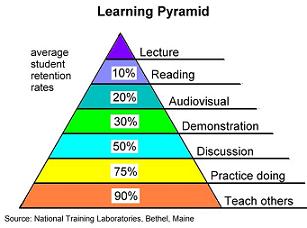 This should be no surprise to many educators that already promote active learning. What is interesting though is the specific definition of what constitutes the cognition behind “being active”. In this case control over the stimulus environment engages the hippocampus. This likely makes (and I am speculating) memorizing something secondary or incidental to a more natural whole-brain activity.
This should be no surprise to many educators that already promote active learning. What is interesting though is the specific definition of what constitutes the cognition behind “being active”. In this case control over the stimulus environment engages the hippocampus. This likely makes (and I am speculating) memorizing something secondary or incidental to a more natural whole-brain activity.
Deep and lasting learning happens automatically as we engage our brains in problem solving, planning and other activities of daily life. The learning process becomes problematic when we make it our primary focus or de-contextualize it and engage in formal learning in a classroom. Active learning changes our cognitive priorities and gets other brain regions involved and produces better outcomes. As we move to the base of learning pyramid (shown above) we are engaging student’s in “designed experiences” rather than formal learning exercises and retention increases dramatically.
Reading, lectures and other devices of formal learning are still important, especially as they set up the designed experiences of learning or to help debrief them. If we want to optimize educational processes for how student’s minds actually work we must design and deliver experiences not lessons.

Posted in Cognitive Training, Technique | 1 Comment »
December 9th, 2010
Instead of begging friends, chasing a grant, pitching a VC or making a presentation to the board for funding you can use crowdsourcing to get capital for your brilliant idea. Crowdfunding uses a internet-based microfinancing approach to pitch the crowd collecting many small promises to fund.
Many crowdfunding sites have sprung up. Some focus on specific types of ideas, for example RocketHub funds projects in the creative arts, while others such as KickStarter are general purpose. Some sites extract a fee for funded projects (5-7%) but otherwise there are no costs. Amounts raised seem small but often happen quickly. For example, Diaspora raised $10K in 39 days. The model is even being tested as a funding mechanism for scientific research – see FundScience.
 From a cognitive design perspective the micro financiers are getting a kick (intangible value or mental energy) from helping to fund an innovative idea. You can select the projects to fund, monitor its progress and in many sites have to pay nothing unless it is fully funded. For little to no financial investment you can have the pleasure and satisfaction of supporting dreams and make the world a better place through innovation. A good deal. But the effects go deeper. As Lawton and Marom point out in their book: The Crowdfunding Revolution:
From a cognitive design perspective the micro financiers are getting a kick (intangible value or mental energy) from helping to fund an innovative idea. You can select the projects to fund, monitor its progress and in many sites have to pay nothing unless it is fully funded. For little to no financial investment you can have the pleasure and satisfaction of supporting dreams and make the world a better place through innovation. A good deal. But the effects go deeper. As Lawton and Marom point out in their book: The Crowdfunding Revolution:
”Even as exciting, is that crowdfunding links funding with the social dynamics and affinity groups which naturally surround efforts that resonate with our many motivations. That alone, is enough to cause a monumental shift in the way business and organizations operate.”
Interested to hear from readers that have used crowdfunding.

Posted in Books, Service Innovation | 3 Comments »
December 7th, 2010
Five graduate students at IIT’s Institute of Design working with Wheelwell want to design and take to market a new wheelchair. They are raising money for the effort on the Pepsi Refresh Challenge Site. Check them out and cast some votes. 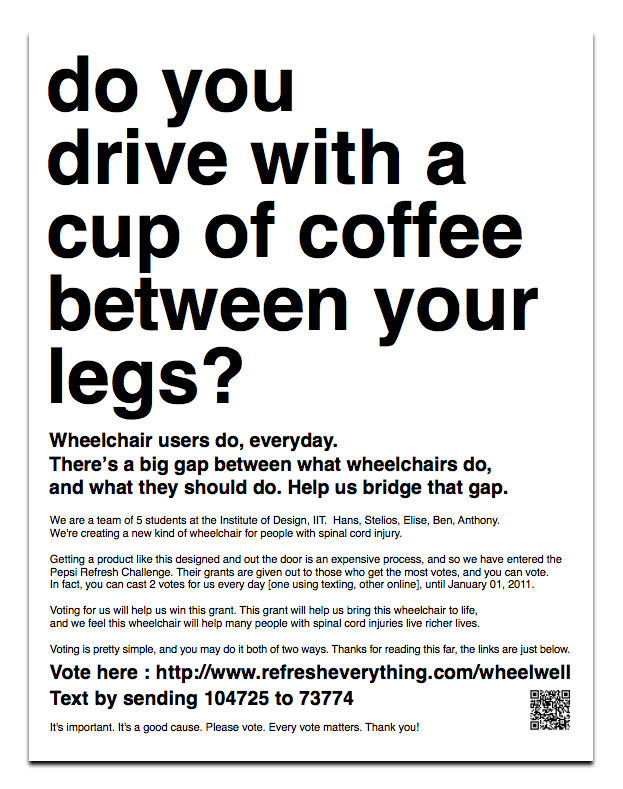 The goal is to design an affordable power-assisted (combines electric and manual modes) chair for people with spinal cord injuries. They are looking for $250K to research, engineer, design and test 3 prototype hybrid chairs. Pepsi will provide the money if they get enough votes.
The goal is to design an affordable power-assisted (combines electric and manual modes) chair for people with spinal cord injuries. They are looking for $250K to research, engineer, design and test 3 prototype hybrid chairs. Pepsi will provide the money if they get enough votes.

Posted in Design, Events | 3 Comments »
December 6th, 2010
Cigarettes have been characterized as a nicotine delivery system. There are over a billion people that smoke them worldwide. It is increasing. The World Bank Group estimates that between 80,000 – 100,000 young people take up smoking cigarettes per day. According to the American Heart Association about 49 million adults in the US smoke them.
A new type of cigarette, called the electronic cigarette, e-cigarette or just the e-cig, has hit the market. It is smokeless. Instead of burning tobacco you use a battery to vaporize and inhale a nicotine solution. It is unregulated. It can in theory be consumed where smoking is banned.
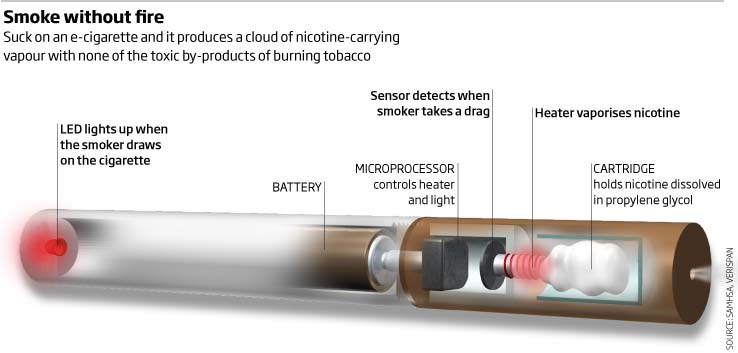
These new electronic nicotine delivery systems are just now being studied. I found some research on EurekAlert! that is sounding an alarm:
To address this question, researchers at the University of California, Riverside evaluated five e-cigarette brands and found design flaws, lack of adequate labeling, and several concerns about quality control and health issues. They conclude that e-cigarettes are potentially harmful and urge regulators to consider removing e-cigarettes from the market until their safety is adequately evaluated.”
There are more than five brands on the market. Although I could not find a formal market study, there are newspaper articles that claim the market is growing fast. Ironically, the high price of traditional cigarettes have made the e-cig technology affordable.
According to Smoke Power here is how they work:
”… the user inhales on the electronic cigarette, this causes an air flow sensor to signal to the inbuilt microprocessor, that in turn activates the atomizer. The atomizer converts the liquid nicotine in the cartridge into a vapour (by atomization), which is digested by the user. Simultaneously, a vapor is released from the glycol by the atomizer to resemble ‘smoke’. “
They include tobacco flavoring, look like a cigarette and produce vapor like smoke so they are trying to meet the cognitive needs of smokers with the design.
Interested to hear from readers that have used e-cigs or that have strong opinions about them.
Source of Image: Electronic Cigarette Comparison

Posted in Behavior Change, Cognitive Bias, Design, Examples | 20 Comments »
December 1st, 2010
I am just starting a small project focusing on students sending and receiving off-topic text messages during class. This came about in part because of the series of posts on the Cognitive Design Blog about the topic.
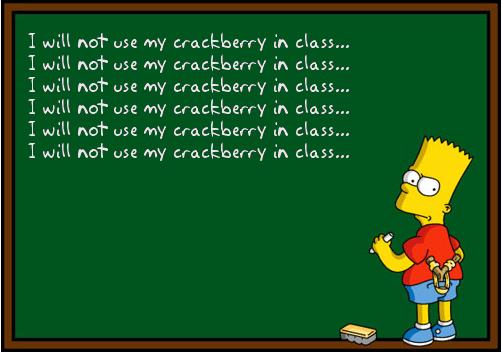
MSNBC posted the results of recent 269 student survey that had some interesting findings:
- 90% of the students text during class
- 50% claim it is easy to do
- 10% do it during exams
- 3% use texting to cheat
Some professors have instituted a no-texting policy resulting in a “zero” if caught. At least one professor leaves the room when he detects texting. In another approach instructors ask students to bring phones and use them as a polling technology during the lecture. The resulting text messages are displayed on a screen and used to faciltate discussion. This may or may not minimize off-topic texting by the same student group.
There is an important related issue. Working adults frequently text, email or IM during business meetings.
How can we use cognitive design to approach texting off-topic during class?

Posted in Behavior Change, Examples, Service Innovation | No Comments »
 The placebo effect is powerful and widespread in medicine. It involves patients getting better when they take a medication or therapy that has no clinical value or active ingredients. Often used as a control to test the efficacy of other treatments, the impact of placebos demonstrates the power of perception and belief in creating change. Indeed, the placebo effect is one reason I am high on cognitive design, a think-and-feel can have as much functional impact as a hammer and nail. It is the real thing not frosting on the design cake. It turns out we all have our placebos.
The placebo effect is powerful and widespread in medicine. It involves patients getting better when they take a medication or therapy that has no clinical value or active ingredients. Often used as a control to test the efficacy of other treatments, the impact of placebos demonstrates the power of perception and belief in creating change. Indeed, the placebo effect is one reason I am high on cognitive design, a think-and-feel can have as much functional impact as a hammer and nail. It is the real thing not frosting on the design cake. It turns out we all have our placebos.  If this effect can be reproduce in other contexts it signals an important development for cognitive designers. It illustrates the importance of ritual (in this case the clinical ritual of taking medications) in creating change. This may support arguments claiming prayer, teaching and leadership communication involve placebo-like effects.
If this effect can be reproduce in other contexts it signals an important development for cognitive designers. It illustrates the importance of ritual (in this case the clinical ritual of taking medications) in creating change. This may support arguments claiming prayer, teaching and leadership communication involve placebo-like effects.





 This should be no surprise to many educators that already promote active learning. What is interesting though is the specific definition of what constitutes the cognition behind “being active”. In this case control over the stimulus environment engages the hippocampus. This likely makes (and I am speculating) memorizing something secondary or incidental to a more natural whole-brain activity.
This should be no surprise to many educators that already promote active learning. What is interesting though is the specific definition of what constitutes the cognition behind “being active”. In this case control over the stimulus environment engages the hippocampus. This likely makes (and I am speculating) memorizing something secondary or incidental to a more natural whole-brain activity.


